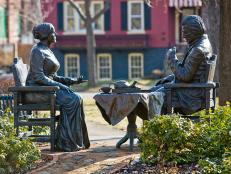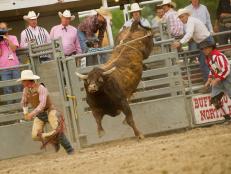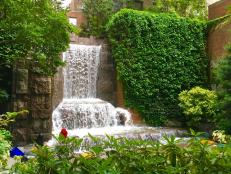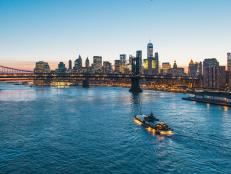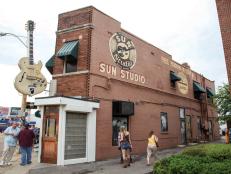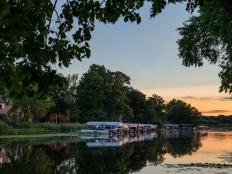10 Old-School NYC Sites
The Bowery Boys—also known as Tom Meyers and Greg Young—entertain listeners each month with their podcasts about New York’s fascinating past. Now their fans can explore pre-1898 Manhattan’s famous sites, historic neighborhoods, cobblestone streets and much more in their book, The Bowery Boys: Adventures in Old New York (Ulysses Press). Join Roam for a tour of ten sites on their “don’t-miss” list.

Greg Young
The Bowery Boys call Delmonico’s, which opened in 1827, the city’s “first great restaurant.” Modeled after European restaurants, it began as a small café and pastry shop. Fire destroyed the structure in 1835, but the owners rebuilt, incorporating marble pillars said to be imported from the ruins of Pompeii, and adding private dining rooms and a cellar complete with 16,000 bottles of French wine. Diners can still find a Delmonico’s restaurant at 56 Beaver Street (at South William).
More than 450,000 immigrants passed through Ellis Island after the government moved its processing services there in 1892. But the island was once the site of a small defense post, Fort Gibson. Part of an excavated wall from the fort can still be seen; Fort Gibson never saw any significant military action, Young and Meyers note. It was later dismantled and served as an ammunition supply depot during the Civil War.

Greg Young
The High Bridge over the Harlem River connects Manhattan and the Bronx, and it’s the oldest existing bridge in New York. Built in the mid-19th century as part of an aqueduct system that delivered water from the Croton River, the 1,450 foot-long bridge was eventually closed, when underground pipes were installed. But the High Bridge was restored and reopened in 2015 for pedestrians and bicyclists.

Greg Young
New York City’s second-oldest cemetery, and one of the oldest burial grounds in the country, is located at 55 St. James Place in Chinatown. You can’t get past the locked gates at First Shearith Israel Graveyard, also known as Chatham Square Cemetery, but you can peer past them to see tombstones written in English, Spanish and Hebrew. The graveyard, which dates back to 1682, was once outside the city limits. Today it’s maintained by Congregation Shearith Israel, and a special ceremony is held each year on the Sunday before Memorial Day to commemorate patriots from the Revolutionary War.

Greg Young
Named for the last British Governor of colonial New York City, what we now call Fort Tryon Park was the site of the Battle of Fort Washington. In 1917, John D. Rockefeller, Jr. led the effort to develop the land as a park, even purchasing hundreds of acres of New Jersey waterfront to help preserve the view. Today, the park contains the city’s largest public-access garden and offers scenic views of the Hudson River and the Palisades. It’s also home to the Cloisters, an affiliate of the Metropolitan Museum of Art.

Greg Young
Built in the 1830s, the identical row houses in Washington Square Park, built as luxury residences for the upper class, once faced a military parade ground. Today, the homes are among the finest examples of Greek revival architecture still remaining in America. Notable residents included realist painter Edward Hopper and author Henry James.

Greg Young
Staple Street, Tribeca
The Bowery Boys write, “Tribeca has perhaps the greatest collection of alleyways in all of New York City,” and the best of these may be Staple Street. Just wide enough for a horse and carriage to navigate, Staple Street features a magnificent skybridge built in 1907. The bridge links two buildings that once served as New York Hospital’s Hudson Street House of Relief and its ambulance annex.

Greg Young
Many songwriters and music publishers once congregated on the street nicknamed Tin Pan Alley. Young and Meyers say the name may have come from all the dissonant sounds that poured out of the buildings. The many musical styles that were woven together here became popular with the American public, thanks to performances on vaudeville stages, in minstrel shows and at concert halls. George Gershwin got his start here, as did Harry Warren, an Italian immigrant who went on to write “Chattanooga Choo Choo” and “Lullaby of Broadway.” Eventually music publishers and songwriters began to move on to other locations, such as Times Square. Tin Pan Alley is not a protected historic district, but it's a great reminder of America’s musical past.

Greg Young
Many of the fascinating characters in Young and Meyers' book were laid to rest in Trinity’s uptown cemetery in northern Manhattan. It’s also the resting place of author Clement Clarke Moore, who penned A Visit from St. Nicholas (popularly known as "‘Twas the Night Before Christmas"), as well as naturalist John James Audubon, actor Jerry Orbach and industrialist John Jacob Aster. Maps for a walking tour of the grounds are available.

Greg Young
Orchard Street, on the city's Lower East Side, was named for an actual orchard that once grew in the area. Irish and German immigrants crowded into the tenement housing that sprang up here, eventually followed by Russians and East Europeans. Most of the tenements, Young and Meyers say, doubled as workspaces for the poor who lived in them, and a thriving pushcart industry was born.

Greg Young
